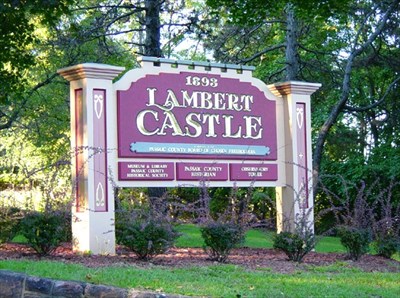
Lambert Castle/Garret Museum
Posted by:  chstress53
chstress53
N 40° 53.744 W 074° 09.154
18T E 571382 N 4527528
This castle/museum houses the oddest collection of spoons. The largest known hoard of spoons in the world.
(973) 881-2761.
Waymark Code: WM462
Location: New Jersey, United States
Date Posted: 11/26/2005
Views: 193
After over a decade of being tucked away in storage, a portion of the world’s largest collection of spoons is once again on exhibition at Lambert Castle's Museum.
The Bertha Schaefer Koempel Spoon Collection, consisting of over 5,400 individual pieces, is considered the largest grouping of its kind in the world. In fact, this spoon collection is so famous that it was the subject of a question on the popular game show Jeopardy.
The collection represents a range of commemorative-type spoons that were collected by the late Bertha Schaefer Koempel (1882-1966) over the course of her lifetime. There are spoons of every shape and description and from every State in the Union as well as from most countries around the world. She began collecting spoons as a young girl while growing up in Paterson, New Jersey. In those days, practically every gift shop throughout the world sold souvenir spoons which usually depicted scenic or historic views of the area in which they were purchased. Over the years, relatives and friends would present her with souvenir spoons from their travels, and thus this extraordinary collection emerged.
It was Mrs. Koempel’s wish for her spoon collection to remain intact after her death and to be placed on display for all people to enjoy as she had. In 1967, her estate donated the entire collection to the Passaic County Historical Society at Lambert Castle Museum, where it was placed on exhibition shortly thereafter. However, in the mid-1990s, Lambert Castle was closed for a multi-year restoration and the spoons were removed and placed in storage.
Now after ten years, the spoons, are on display in an on-going exhibition at Lambert Castle's Museum. These spoons are grouped into seven subject categories: nautical, religious, Scandinavian, enameled figures, novelties, Middle Eastern/North African, and spoons made from natural/organic/animal materials. In the future, other subject groupings will replace the spoons currently on display in order that the entire collection may be rotated over time for viewing by museum visitors, as Mrs. Koempel had wished.
Many of the spoons are beautiful examples of craftsmanship made by outstanding jewelers and silversmiths throughout the world. Some have bowls with miniature paintings in enamel depicting the scenery and native people from the areas where they were made. Other spoons feature mechanical parts, such as the turning blades on the windmill spoons from Holland as well as the spoons with keepsake lockets that open to reveal tiny representations of mummies from the Middle East.
